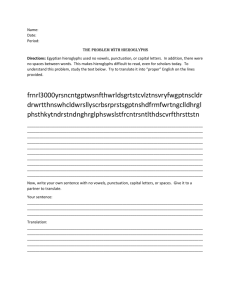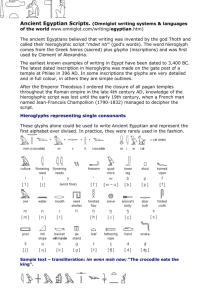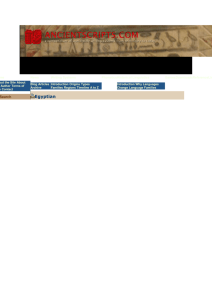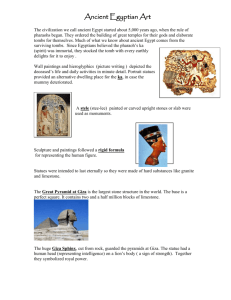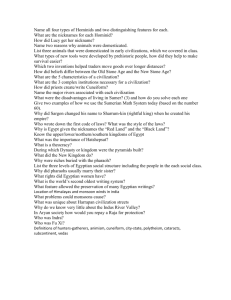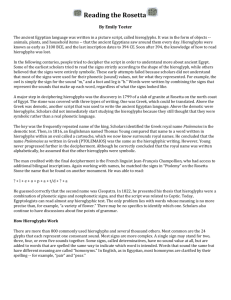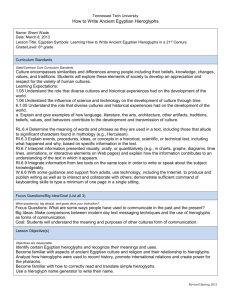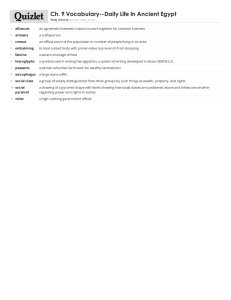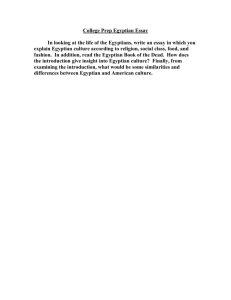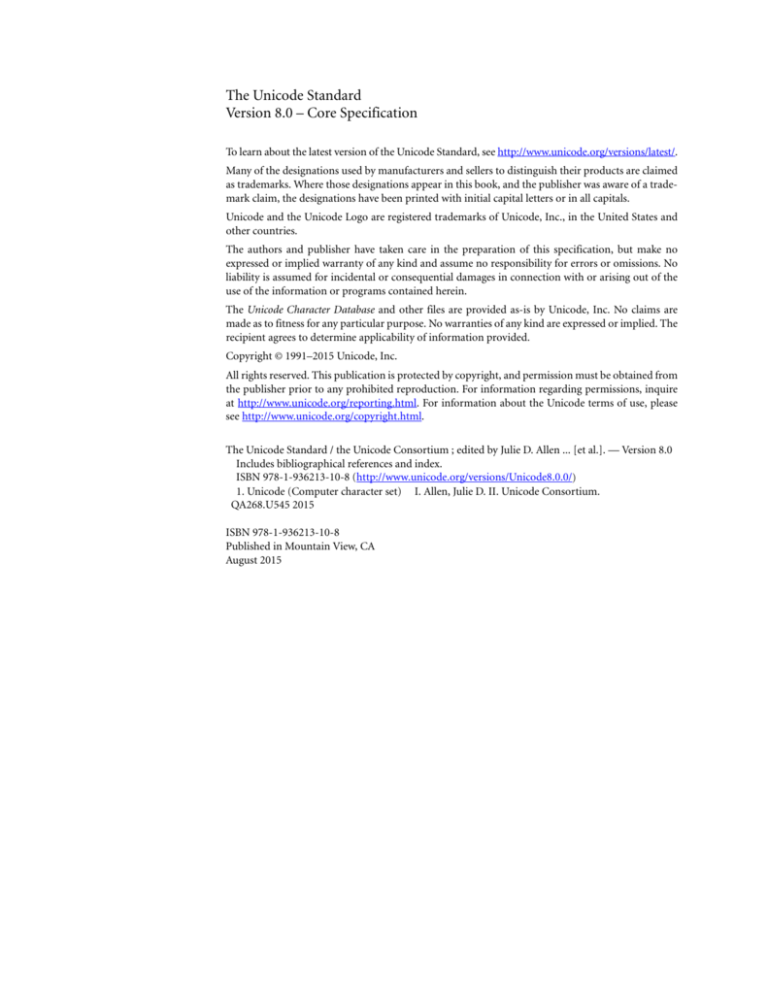
The Unicode Standard
Version 8.0 – Core Specification
To learn about the latest version of the Unicode Standard, see http://www.unicode.org/versions/latest/.
Many of the designations used by manufacturers and sellers to distinguish their products are claimed
as trademarks. Where those designations appear in this book, and the publisher was aware of a trademark claim, the designations have been printed with initial capital letters or in all capitals.
Unicode and the Unicode Logo are registered trademarks of Unicode, Inc., in the United States and
other countries.
The authors and publisher have taken care in the preparation of this specification, but make no
expressed or implied warranty of any kind and assume no responsibility for errors or omissions. No
liability is assumed for incidental or consequential damages in connection with or arising out of the
use of the information or programs contained herein.
The Unicode Character Database and other files are provided as-is by Unicode, Inc. No claims are
made as to fitness for any particular purpose. No warranties of any kind are expressed or implied. The
recipient agrees to determine applicability of information provided.
Copyright © 1991–2015 Unicode, Inc.
All rights reserved. This publication is protected by copyright, and permission must be obtained from
the publisher prior to any prohibited reproduction. For information regarding permissions, inquire
at http://www.unicode.org/reporting.html. For information about the Unicode terms of use, please
see http://www.unicode.org/copyright.html.
The Unicode Standard / the Unicode Consortium ; edited by Julie D. Allen ... [et al.]. — Version 8.0
Includes bibliographical references and index.
ISBN 978-1-936213-10-8 (http://www.unicode.org/versions/Unicode8.0.0/)
1. Unicode (Computer character set) I. Allen, Julie D. II. Unicode Consortium.
QA268.U545 2015
ISBN 978-1-936213-10-8
Published in Mountain View, CA
August 2015
423
Chapter 11
Cuneiform and Hieroglyphs
11
The following scripts are described in this chapter:
Sumero-Akkadian Cuneiform
Old Persian
Meroitic
Ugaritic
Egyptian Hieroglyphs
Anatolian Hieroglyphs
Three ancient cuneiform scripts are described in this chapter: Ugaritic, Old Persian, and
Sumero-Akkadian. The largest and oldest of these is Sumero-Akkadian. The other two
scripts are not derived directly from the Sumero-Akkadian tradition but had common
writing technology, consisting of wedges indented into clay tablets with reed styluses. Ugaritic texts are about as old as the earliest extant Biblical texts. Old Persian texts are newer,
dating from the fifth century bce.
Egyptian Hieroglyphs were used for more than 3,000 years from the end of the fourth millennium bce.
Meroitic hieroglyphs and Meroitic cursive were used from around the second century bce
to the fourth century ce to write the Meroitic language of the Nile valley kingdom known
as Kush or Meroë. Meroitic cursive was for general use, and its appearance was based on
Egyptian demotic. Meroitic hieroglyphs were used for inscriptions, and their appearance
was based on Egyptian hieroglyphs.
Anatolian Hieroglyphs date to the second and first millennia bce, and were used to write
the Luwian language, an Indo-European language, in the area of present-day Turkey and
environs.
Cuneiform and Hieroglyphs
424
11.1 Sumero-Akkadian
11.1 Sumero-Akkadian
Cuneiform: U+12000–U+123FF
Sumero-Akkadian Cuneiform is a logographic writing system with a strong syllabic component. It was written from left to right on clay tablets.
Early History of Cuneiform. The earliest stage of Mesopotamian Cuneiform as a complete
system of writing is first attested in Uruk during the so-called Uruk IV period (circa 3500–
3200 bce) with an initial repertoire of about 700 characters or “signs” as Cuneiform scholars customarily call them.
Late fourth millennium ideographic tablets were also found at Susa and several other sites
in western Iran, in Assyria at Nineveh (northern Iraq), at Tell Brak (northwestern Syria),
and at Habuba Kabira in Syria. The writing system developed in Sumer (southeastern Iraq)
was repeatedly exported to peripheral regions in the third, second, and first millennia bce.
Local variations in usage are attested, but the core of the system is the Sumero-Akkadian
writing system.
Writing emerged in Sumer simultaneously with a sudden growth in urbanization and an
attendant increase in the scope and scale of administrative needs. A large proportion of the
elements of the early writing system repertoire was devised to represent quantities and
commodities for bureaucratic purposes.
At this earliest stage, signs were mainly pictographic, in that a relatively faithful facsimile of
the thing signified was traced, although some items were strictly ideographic and represented by completely arbitrary abstractions, such as the symbol for sheep D. Some scholars
believe that the abstract symbols were derived from an earlier “token” system of accounting, but there is no general agreement on this point. Where the pictographs are concerned,
interpretation was relatively straightforward. The head of a bull was used to denote “cattle”;
an ear of barley was used to denote “barley.” In some cases, pictographs were also interpreted logographically, so that meaning was derived from the symbol by close conceptual
association. For example, the representation of a bowl might mean “bowl,” but it could
indicate concepts associated with bowls, such as “food.” Renditions of a leg might variously
suggest “leg,” “stand,” or “walk.”
By the next chronological period of south Mesopotamian history (the Uruk III period,
3200–2900 bce), logographic usage seems to have become much more widespread. In
addition, individual signs were combined into more complex designs to express other concepts. For example, a head with a bowl next to it was used to denote “eat” or “drink.” This
is the point during script development at which one can truly speak of the first Sumerian
texts. In due course, the early graphs underwent change, conditioned by factors such as the
most widely available writing medium and writing tools, and the need to record information more quickly and efficiently from the standpoint of the bureaucracy that spawned the
system.
Cuneiform and Hieroglyphs
425
11.1 Sumero-Akkadian
Clay was the obvious writing medium in Sumer because it was widely available and easily
molded into cushion- or pillow-shaped tablets. Writing utensils were easily made for it by
sharpening pieces of reed. Because it was awkward and slow to inscribe curvilinear lines in
a piece of clay with a sharpened reed (called a stylus), scribes tended to approximate the
pictographs by means of short, wedge-shaped impressions made with the edge of the stylus. These short, mainly straight shapes gave rise to the modern word “cuneiform” from the
Latin cuneus, meaning “wedge.” Cuneiform proper was common from about 2700 bce,
although experts use the term “cuneiform” to include the earlier forms as well.
Geographic Range. The Sumerians did not live in complete isolation, and there is very
early evidence of another significant linguistic group in the area immediately north of
Sumer known as Agade or Akkad. Those peoples spoke a Semitic language whose dialects
are subsumed by scholars under the heading “Akkadian.” In the long run, the Akkadian
speakers became the primary users and promulgators of Cuneiform script. Because of their
trade involvement with their neighbors, Cuneiform spread through Babylonia (the
umbrella term for Sumer and Akkad) to Elam, Assyria, eastern Syria, southern Anatolia,
and even Egypt. Ultimately, many languages came to be written in Cuneiform script, the
most notable being Sumerian, Akkadian (including Babylonian, Assyrian, Eblaite),
Elamite, Hittite, and Hurrian.
Periods of script usage are defined according to geography and primary linguistic representation, as shown in Table 11-1.
Table 11-1. Cuneiform Script Usage
Archaic Period
(to 2901 bce)
Early Dynastic
(2900–2335 bce)
Old Akkadian
(2334–2154 bce)
Ur III (NeoSumerian)
(2112–2095 bce)
Old Assyrian
Old Babylonian
(1900–1750 bce)
(2004–1595 bce)
Middle Assyrian
(1500-1000 bce)
Middle Babylonian
(1595–627 bce)
Neo-Assyrian
(1000-609 bce)
Neo-Babylonian
(626–539 bce)
Hittite
(1570-1220 bce)
Elamite
(2100–360 bce)
Sources and Coverage. The base character repertoire for the Cuneiform block was distilled
from the list of Ur III signs compiled by the Cuneiform Digital Library Initiative (UCLA) in
union with the list constructed independently by Miguel Civil. This repertoire is comprehensive from the Ur III period onward. Old Akkadian and Archaic Cuneiform are not cov-
Cuneiform and Hieroglyphs
426
11.1 Sumero-Akkadian
ered by the repertoire in this block. Signs specific to the Early Dynastic period are encoded
separately in the Early Dynastic Cuneiform block.
Simple Signs. Most Cuneiform signs are simple units; each sign of this type is represented
by a single character in the standard.
Complex and Compound Signs. Some Cuneiform signs are categorized as either complex
or compound signs. Complex signs are made up of a primary sign with one of more secondary signs written within it or conjoined to it, such that the whole is generally treated by
scholars as a unit; this includes linear sequences of two or more signs or wedge-clusters
where one or more of those clusters have not been clearly identified as characters in their
own right. Complex signs, which present a relative visual unity, are assigned single individual code points irrespective of their components.
Compound signs are linear sequences of two or more signs or wedge-clusters generally
treated by scholars as a single unit, when each and every such wedge-cluster exists as a
clearly identified character in its own right. Compound signs are encoded as sequences of
their component characters. Signs that shift from compound to complex, or vice versa,
generally have been treated according to their Ur III manifestation.
Mergers and Splits. Over the long history of Cuneiform, a number of signs have simplified
and merged; in other cases, a single sign has diverged and developed into more than one
distinct sign. The choice of signs for encoding as characters was made at the point of maximum differentiation in the case of either mergers or splits to enable the most comprehensive set for the representation of text in any period.
Fonts. Fonts for the representation of Cuneiform text may need to be designed distinctly
for optimal use for different historic periods. For example, in the late third millennium
bce, the head of the glyph of the lower right-hand stroke in a ring of four strokes changed
its orientation. In earlier times it sloped down to the left, as shown in the glyph for
U+1212D, but was later replaced by a stroke in which the head sloped up to the right, as
shown in the glyph for U+12423. The glyphs in the code charts do not use a consistent style
for these kinds of historic features.
U+1212D
U+12423
Fonts for some periods will contain duplicate glyphs depending on the status of merged or
split signs at that point of the development of the writing system.
Glyph Variants Acquiring Independent Semantic Status. Glyph variants such as U+122EC
M cuneiform sign ta asterisk, a Middle Assyrian form of the sign U+122EB N cuneiform sign ta, which in Neo-Assyrian usage has its own logographic interpretation, have
been assigned separate code positions. They are to be used only when the new interpretation applies.
Cuneiform and Hieroglyphs
427
11.1 Sumero-Akkadian
Formatting. Cuneiform was often written between incised lines or in blocks surrounded by
drawn boxes known as case rules. These boxes and lines are considered formatting and are
not part of the script. Case ruling and the like are not to be treated as punctuation.
Ordering. The characters are encoded in the Unicode Standard in Latin alphabetical order
by primary sign name. Complex signs based on the primary sign are organized according
to graphic principles; in some cases, these correspond to the native analyses.
Other Standards. There is no standard legacy encoding of Cuneiform primarily because it
was not possible to encode the huge number of characters in the pre-Unicode world of 8bit fonts.
Cuneiform Numbers and Punctuation: U+12400–U+1247F
Cuneiform Punctuation. A small number of signs are occasionally used in Cuneiform to
indicate word division, repetition, or phrase separation.
Cuneiform Numerals. In general, numerals have been encoded separately from signs that
are visually identical but semantically different (for example, U+1244F B cuneiform
numeric sign one ban2, U+12450 C cuneiform numeric sign two ban2, and so on,
versus U+12226 B cuneiform sign mash, U+1227A C cuneiform sign pa, and so on).
Early Dynastic Cuneiform: U+12480–U+1254F
This block contains characters covering extensions for Cuneiform for the Early Dynastic
period, 2900-2335 bce. The writing of this period is attested primarily from two sites, FQra
and Tell AbU-SalQbSkh, both located in the southern part of Iraq. The attestations include
administrative, legal, lexical, and literary texts.
The repertoire in this block is compiled primarily from the modern Assyriological sign list
of the Early Dynastic period, Liste der archaischen Keilschriftzeichen aus Fara (abbreviated
LAK), with a few additions derived from other sources. Only Early Dynastic signs not
already included in the main Cuneiform block have been added here.
Cuneiform and Hieroglyphs
428
11.2
Ugaritic
11.2 Ugaritic
Ugaritic: U+10380–U+1039F
The city state of Ugarit was an important seaport on the Phoenician coast (directly east of
Cyprus, north of the modern town of Minet el-Beida) from about 1400 bce until it was
completely destroyed in the twelfth century bce. The site of Ugarit, now called Ras Shamra
(south of Latakia on the Syrian coast), was apparently continuously occupied from Neolithic times (circa 5000 bce). It was first uncovered by a local inhabitant while plowing a
field in 1928 and subsequently excavated by Claude Schaeffer and Georges Chenet beginning in 1929, in which year the first of many tablets written in the Ugaritic script were discovered. They later proved to contain extensive portions of an important Canaanite
mythological and religious literature that had long been sought and that revolutionized
Biblical studies. The script was first deciphered in a remarkably short time jointly by Hans
Bauer, Edouard Dhorme, and Charles Virolleaud.
The Ugaritic language is Semitic, variously regarded by scholars as being a distinct language
related to Akkadian and Canaanite, or a Canaanite dialect. Ugaritic is generally written
from left to right horizontally, sometimes using U+1039F s ugaritic word divider. In the
city of Ugarit, this script was also used to write the Hurrian language. The letters U+1039B
p ugaritic letter i, U+1039C q ugaritic letter u, and U+1039D r ugaritic letter
ssu are used for Hurrian.
Variant Glyphs. There is substantial variation in glyph representation for Ugaritic. Glyphs
for U+10398 s ugaritic letter thanna, U+10399 t ugaritic letter ghain, and
U+1038F r ugaritic letter dhal differ somewhat between modern reference sources, as
do some transliterations. U+10398 s ugaritic letter thanna is most often displayed
with a glyph that looks like an occurrence of U+10393 v ugaritic letter ain overlaid
with U+10382 u ugaritic letter gamla.
Ordering. The ancient Ugaritic alphabetical order, which differs somewhat from the modern Hebrew order for similar characters, has been used to encode Ugaritic in the Unicode
Standard.
Character Names. Some of the Ugaritic character names have been reconstructed; others
appear in an early fragmentary document.
Cuneiform and Hieroglyphs
429
11.3
Old Persian
11.3 Old Persian
Old Persian: U+103A0–U+103DF
The Old Persian script is found in a number of inscriptions in the Old Persian language
dating from the Achaemenid empire. Scholars today agree that the character inventory of
Old Persian was invented for use in monumental inscriptions of the Achaemenid king,
Darius I, by about 525 bce. Old Persian is an alphabetic writing system with some syllabic
aspects. While the shapes of some Old Persian letters look similar to signs in Sumero-Akkadian Cuneiform, it is clear that only one of them, U+103BE @ old persian sign la, was
actually borrowed. It was derived from the New Assyrian historic variant A of SumeroAkkadian U+121B7 ? cuneiform sign la, because la is a foreign sound not used in the
Old Persian language.
Directionality. Old Persian is written from left to right.
Repertoire. The repertoire contains 36 signs. These represent consonants, vowels, or consonant plus vowel syllables. There are also five numbers, one word divider, and eight ideograms. It is considered unlikely that any additional characters will be discovered.
Numerals. The attested numbers are built up by stringing the base numbers (1, 2, 10, 20,
and 100) in sequences.
Variants. The signs U+103C8 old persian sign auramazdaa and U+103C9 old persian
sign auramazdaa-2, and the signs U+103CC old persian sign dahyaaush and
U+103CD old persian sign dahyaaush-2, have been encoded separately because their
conventional attestation in the corpus of Old Persian texts is quite limited and scholars
consider it advantageous to distinguish the forms in plain text representation.
Cuneiform and Hieroglyphs
430
11.4
Egyptian Hieroglyphs
11.4 Egyptian Hieroglyphs
Egyptian Hieroglyphs: U+13000–U+1342F
Hieroglyphic writing appeared in Egypt at the end of the fourth millennium bce. The writing system is pictographic: the glyphs represent tangible objects, most of which modern
scholars have been able to identify. A great many of the pictographs are easily recognizable
even by nonspecialists. Egyptian hieroglyphs represent people and animals, parts of the
bodies of people and animals, clothing, tools, vessels, and so on.
Hieroglyphs were used to write Egyptian for more than 3,000 years, retaining characteristic
features such as use of color and detail in the more elaborated expositions. Throughout the
Old Kingdom, the Middle Kingdom, and the New Kingdom, between 700 and 1,000 hieroglyphs were in regular use. During the Greco-Roman period, the number of variants, as
distinguished by some modern scholars, grew to somewhere between 6,000 and 8,000.
Hieroglyphs were carved in stone, painted on frescos, and could also be written with a reed
stylus, though this cursive writing eventually became standardized in what is called hieratic
writing. The hieratic forms are not separately encoded; they are simply considered cursive
forms of the hieroglyphs encoded in this block.
The Demotic script and then later the Coptic script replaced the earlier hieroglyphic and
hieratic forms for much practical writing of Egyptian, but hieroglyphs and hieratic continued in use until the fourth century ce. An inscription dated August 24, 394 ce has been
found on the Gateway of Hadrian in the temple complex at Philae; this is thought to be
among the latest examples of Ancient Egyptian writing in hieroglyphs.
Structure. Egyptian hieroglyphs made use of 24 letters comprising a true alphabet. In addition to these phonetic characters, Egyptian hieroglyphs made use of a very large number of
logographic characters (called “logograms” or “ideograms” by Egyptologists), some of
which could be read as a word, and some of which had only a semantic determinative function, to enable the reader to distinguish between words which were otherwise written the
same. Within a word, characters were arranged together to form an aesthetically-pleasing
arrangement within a notional square.
Directionality. Characters may be written left-to-right or right-to-left, generally in horizontal lines, but often—especially in monumental texts—in vertical columns. Directionality of a text is usually easy to determine because one reads a line facing into the glyphs
depicting the faces of people or animals.
Egyptian hieroglyphs are given strong left-to-right directionality in the Unicode Standard,
because most Egyptian editions are published in English, French, or German, and left-toright directionality is the conventional presentation mode. When left-to-right directionality is overridden to display Egyptian hieroglyphic text right to left, the glyphs should be
mirrored from those shown in the code charts.
Rendering. The encoded characters for Egyptian hieroglyphs in the Unicode Standard simply represent basic text elements, or signs, of the writing system. A higher-level protocol is
Cuneiform and Hieroglyphs
431
11.4
Egyptian Hieroglyphs
required to represent the arrangement of signs into notional squares and for effects involving mirroring or rotation of signs within text. This approach to encoding the hieroglyphs
works well in the context of pre-existing conventions for the representation of Egyptian
text, which use simple markup schemes to indicate such formatting.
The most prominent example of such conventions in use since computers were introduced
into Egyptology in the late 1970s and the early 1980s is called the Manuel de Codage (MdC),
published in 1988. The MdC conventions make use of ASCII characters to separate hieroglyphic signs and to indicate the organization of the elements in space—that is, the position of each sign, as arranged in a block. For example, the hyphen-minus “-” is used to
separate adjacent hieroglyphic blocks. The colon “:” indicates the superposition of one
hieroglyphic sign over another. The asterisk “*” indicates the left-right juxtaposition of two
hieroglyphic signs within a visual block.
For example, using the MdC conventions, the hieroglyphic representation of the name
Amenhotep would be transliterated as <i-mn:n-R4:t*p>. The lowercase letters represent
transliterations of alphabetic or other phonetic signs, whereas “R4” is the catalog label for
one of the logograms in the standard Gardiner list. The “-”, “:”, and “*” characters provide
the markup showing how the individual signs are visually arranged. The “<” and “>”
bracket characters indicate a cartouche, often used for a king’s name. The Unicode representation of the same hieroglyphic name, using MdC conventions, but substituting Unicode characters for the transliterations and catalog numbers is shown in Table 11-2.
Table 11-2. Hieroglyphic Character Sequence
U+003C
U+131CB
U+002D
U+133E0
U+003A
U+13216
U+002D
U+132B5
U+003A
U+133CF
U+002A
U+132AA
U+003E
less-than sign
egyptian hieroglyph m017 (= y, i)
hyphen-minus
egyptian hieroglyph y005 (= mn)
colon
egyptian hieroglyph n035 (= n)
hyphen-minus
egyptian hieroglyph r004 (= R4)
colon
egyptian hieroglyph x001 (= t)
asterisk
egyptian hieroglyph q003 (= p)
greater-than sign
The interpretation of these MdC markup conventions in text is not part of plain text. Ordinary word processors and plain text display would not be expected to be able to interpret
those conventions to render sequences of Egyptian hieroglyphic signs stacked correctly into
blocks. Instead, such display would require a specialized rendering process familiar with
the layout of Egyptian hieroglyphs. This distinction is illustrated in Figure 11-1. The first
line shows the marked-up MdC sequence for the name of the king, Amenhotep. The second line shows the Unicode hieroglyphic version of that sequence, as interpreted by an
ordinary Unicode plain text rendering process. The third line shows a rendering by a spe-
Cuneiform and Hieroglyphs
432
11.4
Egyptian Hieroglyphs
cialized hieroglyphic rendering process, which can interpret the markup and render a cartouche.
Figure 11-1. Interpretation of Hieroglyphic Markup
Manuel de Codage:
<i-mn:n-R4:t*p>
Unicode Plain Text:
Interpreted Markup:
Other markup schemes have been proposed, which attempt to provide greater flexibility
than MdC by use of more elaborate encodings. XML has also been used to represent Egyptian texts. Such representations also require specialized rendering systems to lay out hieroglyphic text.
Hieratic Fonts. In the years since Champollion published his decipherment of Egyptian in
1824, Egyptologists have shown little interest in typesetting hieratic text. Consequently,
there is no tradition of hieratic fonts in either lead or digital formats. Because hieratic is a
cursive form of the underlying hieroglyphic characters, hieratic text is normally rendered
using the more easily legible hieroglyphs. In principle a hieratic font could be devised for
specialist applications, but as for fonts for other cursive writing systems, it would require
very large ligature tables—even larger than usual, because of the great many hieroglyphic
signs involved.
Repertoire. The set of hieroglyphic characters encoded in this block is loosely referred to as
“the Gardiner set.” However, the Gardiner set was not actually exhaustively described and
enumerated by Gardiner, himself. The chief source of the repertoire is Gardiner’s Middle
Egyptian sign list as given in his Egyptian Grammar (Gardiner 1957). That list is supplemented by additional characters found in his font catalogues (Gardiner 1928, Gardiner
1929, Gardiner 1931, and Gardiner 1953), and by a collection of signs found in the Griffith
Institute’s Topographical Bibliography, which also used the Gardiner fonts.
A few other characters have been added to this set, such as entities to which Gardiner gave
specific catalog numbers. They are retained in the encoding for completeness in representation of Gardiner’s own materials. A number of positional variants without catalog numbers were listed in Gardiner 1957 and Gardiner 1928.
Character Names. Egyptian hieroglyphic characters have traditionally been designated in
several ways:
• By complex description of the pictographs: GOD WITH HEAD OF IBIS, and
so forth.
Cuneiform and Hieroglyphs
433
11.4
Egyptian Hieroglyphs
• By standardized sign number: C3, E34, G16, G17, G24.
• For a minority of characters, by transliterated sound.
The characters in the Unicode Standard make use of the standard Egyptological catalog
numbers for the signs. Thus, the name for U+130F9 egyptian hieroglyph e034 refers
uniquely and unambiguously to the Gardiner list sign E34, described as a “DESERT
HARE” and used for the sound “wn”. The catalog values are padded to three places with
zeros.
Names for hieroglyphic characters identified explicitly in Gardiner 1953 or other sources as
variants for other hieroglyphic characters are given names by appending “A”, “B”, ... to the
sign number. In the sources these are often identified using asterisks. Thus Gardiner’s G7,
G7*, and G7** correspond to U+13146 egyptian hieroglyph g007, U+13147 egyptian
hieroglyph g007a, and U+13148 egyptian hieroglyph g007b, respectively.
Sign Classification. In Gardiner’s identification scheme, Egyptian hieroglyphs are classified according to letters of the alphabet, so A000 refers to “Man and his occupations,” B000
to “Woman and her occupations,” C000 to “Anthropomorphic deities,” and so forth. The
order of signs in the code charts reflects this classification. The Gardiner categories are
shown in headers in the names list accompanying the code charts.
Some individual characters may have been identified as belonging to other classes since
their original category was assigned, but the ordering in the Unicode Standard simply follows the original category and catalog values.
Enclosures. The two principal names of the king, the nomen and prenomen, were normally
written inside a cartouche: a pictographic representation of a coil of rope, as shown in
Figure 11-1.
In the Unicode representation of hieroglyphic text, the beginning and end of the cartouche
are represented by separate paired characters, somewhat like parentheses. Rendering of a
full cartouche surrounding a name requires specialized layout software.
There are a several characters for these start and end cartouche characters, reflecting various styles for the enclosures.
Numerals. Egyptian numbers are encoded following the same principles used for the
encoding of Aegean and Cuneiform numbers. Gardiner does not supply a full set of
numerals with catalog numbers in his Egyptian Grammar, but does describe the system of
numerals in detail, so that it is possible to deduce the required set of numeric characters.
Two conventions of representing Egyptian numerals are supported in the Unicode Standard. The first relates to the way in which hieratic numerals are represented. Individual
signs for each of the 1s, the 10s, the 100s, the 1000s, and the 10,000s are encoded, because in
hieratic these are written as units, often quite distinct from the hieroglyphic shapes into
which they are transliterated. The other convention is based on the practice of the Manual
de Codage, and is comprised of five basic text elements used to build up Egyptian numerals.
There is some overlap between these two systems.
Cuneiform and Hieroglyphs
434
11.5
Meroitic
11.5 Meroitic
Meroitic Hieroglyphs: U+10980–U+1099F
Meroitic Cursive: U+109A0–U+109FF
Meroitic hieroglyphs and Meroitic cursive were used from around the second century bce
to the fourth century ce to write the Meroitic language of the Nile valley kingdom known
as Kush or Meroë. The kingdom originated south of Egypt around 850 bce, with its capital
at Napata, located in modern-day northern Sudan. At that time official inscriptions used
the Egyptian language and script. Around 560 bce the capital was relocated to Meroë,
about 600 kilometers upriver. As the use of Egyptian language and script declined with the
greater distance from Egypt, two native scripts developed for writing Meroitic:
• Meroitic cursive was for general use, and its appearance was based on Egyptian
demotic.
• Meroitic hieroglyphs were used for inscriptions on royal monuments and temples, and their appearance was based on Egyptian hieroglyphs. (See
Section 11.4, Egyptian Hieroglyphs for more information.)
After the fourth century ce, the Meroitic language was gradually replaced by Nubian, and
by the sixth century the Meroitic scripts had been superseded by the Coptic script, which
picked up three additional symbols from Meroitic cursive to represent Nubian.
Although the values of the script characters were deciphered around 1911 by the English
Egyptologist F. L. Griffith, the Meroitic language is still not understood except for names
and a few other words. It is not known to be related to any other language. It may be related
to Nubian.
Structure. Unlike the Egyptian scripts, the Meroitic scripts are almost purely alphabetic.
There are 15 basic consonants; if not followed by an explicit vowel letter, they are read with
an inherent a. There are four vowels: e, i, o, and a. The a vowel is only used for initial a. In
addition, for unknown reasons, there are explicit letters for the syllables ne, te, se, and to.
This may have been due to dialect differences, or to the possible use of n, t, and s as final
consonants in some cases.
Meroitic cursive also uses two logograms for rmt and imn, derived from Egyptian demotic.
Directionality. Horizontal writing is almost exclusively right-to-left, matching the direction in which the hieroglyphs depicting people and animals are looking. This is unlike
Egyptian hieroglyphs, which are read into the faces of the glyphs for people and animals.
Meroitic hieroglyphs are also written vertically in columns.
Shaping. In Meroitic cursive, the letter for i usually connects to a preceding consonant.
There is no other connecting behavior.
Punctuation. The Meroitic scripts were among the earliest to use word division—not
always consistently—to separate basic sentence elements, such as noun phrases, verb
forms, and so on. For this purpose Meroitic hieroglyphs use three vertical dots, represented
Cuneiform and Hieroglyphs
435
11.5
Meroitic
by U+205D tricolon. When Meroitic hieroglyphs are presented in vertical columns, the
orientation of the three dots shifts to become three horizontal dots. This can be represented
either with U+2026 horizontal ellipsis, or in more sophisticated rendering, by glyphic
rotation of U+205D tricolon. Meroitic cursive uses two vertical dots, represented by
U+003A colon.
Symbols. Two ankh-like symbols are used with Meroitic hieroglyphs.
Meroitic Cursive Numbers. Meroitic numbers are found only in Meroitic Cursive. The system consists of numbers one through nine and bases for ranks: tens, hundreds, thousands,
ten thousands, and hundred thousands. The numbers for 100 and higher are systematically
formed by attaching the numbers for one through nine as a multiplier to the respective
base for each rank. There is also a notation for a fractional system based on twelfths, which
simply uses one to eleven dots to represent each fraction.
Cuneiform and Hieroglyphs
436
11.6
Anatolian Hieroglyphs
11.6 Anatolian Hieroglyphs
Anatolian Hieroglyphs: U+14400–U+1467F
Anatolian hieroglyphs appeared on personal seals, monumental inscriptions, and other
objects in the second and first millennia bce in present-day Turkey and surrounding areas.
The script, known also as Luwian or Luvian hieroglyphs, was used primarily to write the
Luwian language.
Structure. Anatolian hieroglyphs contain both syllabic and logographic elements. Words
can be represented by logographs alone, by logographs with a phonetic complement, or
solely by syllabic values.
Directionality. Anatolian hieroglyphs can be written left-to-right, right-to-left, or boustrophedon, and lines are often divided by horizontal rules. Within a line, characters are
grouped vertically, typically from top to bottom, although the characters may be placed out
of phonetic or logical order for aesthetic reasons.
The characters in the Anatolian Hieroglyphs block have a strong left-to-right directionality
(Bidi_Class=L), because publications typically lay out hieroglyphs from left to right. When
Anatolian hieroglyphs are displayed right to left, the glyphs should be mirrored from those
shown in the code charts.
Repertoire. The repertoire of characters is broadly based on the sign catalog of Laroche
(1960), supplemented by additions from later handbooks. Some signs contained in
Laroche are considered variants today, but have been encoded separately to represent the
complete history of Anatolian scholarship and discussions about the decipherment.
Character names for variant signs are usually distinguished by an “A”, “B”, or “C” appended
to the catalog number of the main sign. For example, U+14600 anatolian hieroglyph
a457a is a variant of U+145FF anatolian hieroglyph a457.
A few hieroglyphs developed a simplified, cursive shape, based on the more pictorial shape
of the signs found on monuments. The simplified forms are encoded separately, and are
differentiated in their names.
U+1442B A anatolian hieroglyph a041 (monumental style)
= capere
= syllabic tà
U+1442C B anatolian hieroglyph a041a (cursive style)
= syllabic tà
The script contains a productive grapheme, U+145B1 F anatolian hieroglyph a383 ra
or ri, which appears as a part of several other signs, such as U+145B9 E anatolian
hieroglyph a389. The characters containing this graphic element as part of their form are
not decomposable.
Annotations. Latin names are used traditionally to describe characters used logographically and appear as annotations in the names list. Those characters which have a Luwian
Cuneiform and Hieroglyphs
437
11.6
Anatolian Hieroglyphs
phonetic value or are logosyllabic are identified in the annotations. When a plus sign
appears between two elements in the annotation, the elements are considered a single
graphic unit, whereas a period between the two elements indicates the two elements are
considered graphically separate.
U+1447E C anatolian hieroglyph a107a
= bos+mi
U+14480 D anatolian hieroglyph a107b
= bos.mi
Punctuation. In some texts, word division is indicated by U+145B5 anatolian hieroglyph a386 or its variant U+145B6 anatolian hieroglyph a386a. U+145CE anatolian
hieroglyph a410 begin logogram mark and U+145CF anatolian hieroglyph a410a
end logogram mark sometimes occur in text to mark logograms.
The characters U+145F7 anatolian hieroglyph a450 and U+144EF anatolian hieroglyph a209 are occasionally used to fill blank spaces, often at the end of a word. Spaces are
used in modern renditions of hieroglyphic text.
Numbers. Some of the hieroglyphic signs have been interpreted as having numeric vlaues.
These include values for 1–5, 8–10, 12, 100, and 1000. However, all of the Anatolian hieroglyphs have the General_Category=Other_Letter and no specific numeric values for them
are assigned in the Unicode Character Database.
Rendering. Just as for Egyptian hieroglyphs, only the basic text elements of the script are
encoded. A higher-level protocol is required for the display Anatolian hieroglyphs in a nonlinear layout.
Cuneiform and Hieroglyphs
438
11.6
Anatolian Hieroglyphs

